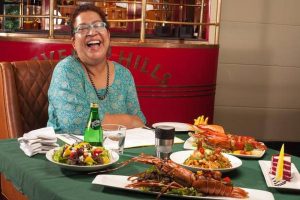The warm and cheerful Marryam Reshii loves everything native about the people and places she visits
 Marryam H Reshii describes herself as very boring person who would rather spend ₹ 3000 on a book than on a handbag or clothes. Yet this travel buff and food writer says she largely ignores guidebooks and prefer to venture on her own for an individual experience. “In Paris, rather than going to the Grand Palais and Petit Palais, I would rather go to a restaurant near the University run by a Tunisian chap who serves osban: stuffed sheep’s stomach, a prized delicacy in Tunisia! Offbeat - that’s me! I may be from Goa, but not only do I not speak the language, I am clueless about most things about Goa. On the other hand, in the last 26 years that I have been married to a Kashmiri, I not only speak the language, but Kashmiris look to me to answer questions about culture and cuisine!” Author of a few travel books, this feature writer recently announced the launch of her latest book, The Flavour of spice.
Marryam H Reshii describes herself as very boring person who would rather spend ₹ 3000 on a book than on a handbag or clothes. Yet this travel buff and food writer says she largely ignores guidebooks and prefer to venture on her own for an individual experience. “In Paris, rather than going to the Grand Palais and Petit Palais, I would rather go to a restaurant near the University run by a Tunisian chap who serves osban: stuffed sheep’s stomach, a prized delicacy in Tunisia! Offbeat - that’s me! I may be from Goa, but not only do I not speak the language, I am clueless about most things about Goa. On the other hand, in the last 26 years that I have been married to a Kashmiri, I not only speak the language, but Kashmiris look to me to answer questions about culture and cuisine!” Author of a few travel books, this feature writer recently announced the launch of her latest book, The Flavour of spice.
How much time did you dedicate to stories attached to food?
There are three books about Kashmir, a dozen food guides and half a dozen sponsored books about various food-related subjects, but when I was asked to do a book about spices, it took me a year just to get around the subject, and more than two years to travel around the country to visit spice plantations, mandis, plantation owners, warehouses for spices, etc. Once I came to grips with the subject, I figured out how to incorporate what I knew. What was infinitely more difficult was to decide what to leave out!
How will you describe this book to someone who is not aware about India spices?
It is the stories about the spices themselves, the sheer variety that exists in a single country and the diverse conditions that they require to grow. Plus the people that grow them and use them in their cuisines. The full monty, basically.
Is it right to connect most spices to Kerala?
Good Lord, no! The only spices that are native to Kerala are black pepper and green cardamom. Today, modest amounts of cloves and cinnamon also are grown there, but they do not fulfil our national requirement. Chillies, cumin, coriander, turmeric are grown, if at all, in tiny amounts: the bulk of those come from other states.
Tell us more about the Chilli chapter. How did you weave stories into it?
The whole miracle of red chillies is how an entire sub-continent took to the little red devils so much so that today, Indian food is defined by how spicy it is because of chillies, whereas Mexican food has used chillies for a few millennia before we did. North India was exposed to red chillies during the reign of Jehangir. Imagine! 450 years ago. Today, nobody can think of desi khana without chillies, though hardly any dish (comparatively speaking) uses black pepper which is endemic to our shores!
There is a chapter each for cumin, coriander, turmeric and chillies, one section each for the fragrant spices like cardamom and nutmeg, and one chapter for the rest of the spices that all of us have in our kitchen but can do without, like ajwain and kalonji.
As a journalist, were you always inclined towards becoming a food and travel writer?
Oh, never! I have done a fair amount in travel journalism during the ’80s, but it was only in the ’90s, after having done two stories about food writers in quick succession, that the paper that I worked for at that time decided to off-load all their food stories onto yours truly!
What came first to you? Food or travel? Did one influence the other?
Travel came first. Without a whiff of food. In the ’80s, there was no such thing as writing about food. After my children were born, travel writing was not an option and that, fortuitously enough, was when food writing became a subject. However, it was never an option to make a career out of it: people thought I was daft to leave a newspaper job to chase a rainbow.


